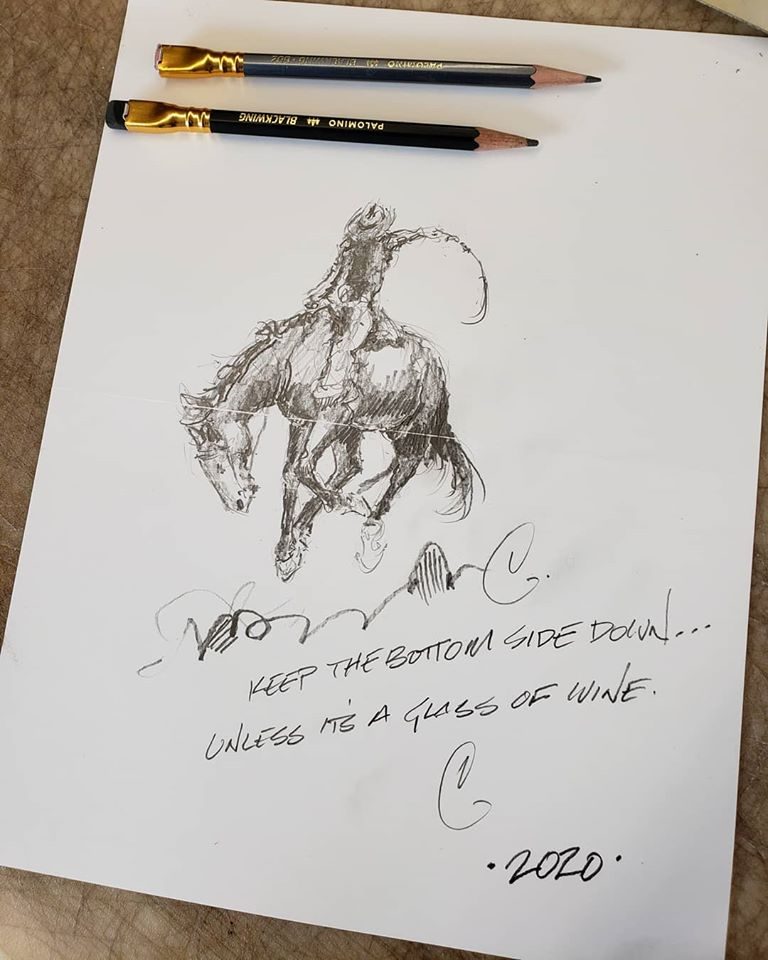
Back in what feels like another lifetime, nearly three years ago, I had the opportunity to spend a day with a roomful of rawhide braiders – and the one person who arrived in the class to a chorus of “Who let in the Saddlemaker?”
Today, when I opened my social media page, the first post I saw was the sketch above with the words of advice from that artist and saddlemaker, Cary Schwarz. His drawing stirred my memories of the day of shared interests in the folk arts along with the friendships and connections that emerged over distances and time. It also reminded me of a book title shared that day.
Cary told me about Matthew Crawford’s book Shop Class as Soulcraft. The book builds the case that as we see the rise in “knowledge workers,” we are witnessing how, “The disappearance of tools from our common education is a first step toward a wider ignorance of the world of artifacts we inhabit.” Using his knowledge and experience as an electrician and a motorcycle mechanic along with his background in philosophy (Ph.D. Chicago), Crawford writes about the benefits of mastering real, tangible things.
For those of you who may feel tempted to dismiss Crawford as having created a spinoff of an antiquated Zen and the Art of Motorcycle Maintenance (Robert Pirsig), stay with me here. Where Pirsig rambles, Crawford cuts to the core, building a strong case for the need to maintain our manual competence by making, by building, by fixing, by doing. And in that process, gaining a more fulfilling and sustainable life. Moreover, Crawford maintains that working with our hands “rouses us from passivity and dependence on consumer culture.” His is a call for us to “live more concretely in an ever more abstract world.”
That thought brings me to the why, the drive, the passion that underlies the physical act of creating. As an aside, I am not speaking about the fun, the adventure, the excitement of envisioning, of visualizing, and, yes, of imagining that can come from working with our mind. I am writing about the pain and joy of giving that view, that perception, a voice in a physical form. That is the act of creating. And in that action of providing form, we interact with the material world, the “real” world. Therein lies pain, joy, suffering, and hope. But, as Aristotle observed, “all human beings by nature desire to know,” and Crawford argues in his book that “real knowledge arises through confrontations with real things.”
So, what is it then that carries those of us who create through the disorder of the worry, fear, pain, suffering, even anger and sorrow in putting form to our voices? I have come to believe that it is the anticipation and reverence we feel towards our chosen medium when we approach the work of creating. It’s the feeling that touches me each time I sit down to write. I see Homer’s words, “Sing in me, oh Muse, and through me tell the story.”
The will to push through the tides of fear and worry comes from the artist’s relationship and view of the medium in which they work. It is not through convenience or what sells does an artist create. It is the love of the medium because interacting with it provides the artist with the material way to share the inner and unique voice. And, therein, lies the joy. For a painter, it could be the feel of a brush in hand or the smell of the paint as a tube is opened. For the ceramicist, it could be the organic feel, the life within the clay as it turns on the wheel. For this fibre artist, it is the feel, the handle of the fibers or threads as I work with them. For a calligrapher, it is the memory that is stirred from watching the ink flow out of an ink pen.
But there is more than that anticipatory joy. What I am talking about is not “Art Appreciation for the Couch Potato.” There is an interaction, a reciprocal action of reverence that flows from the artist and medium to the viewer or user. Crawford holds that, “Shared memories attach to the material souvenirs of our lives, and producing them is a kind of communion, with others and with the future.” I have said often, and sometimes loudly, that what we create with intention, no matter the medium or reason, provides a view of us. It is us reflected from our past, and it is our message to the future.
Every time I go out our back door, I pass the railing on which my great-grandfather’s saddle resides. He rode that saddle into an untamed and unnamed Montana in the early 1860’s. The saddle’s smooth leather, shiny with use and cracked in places from age, reminds me of those who paved the way for our family.
And, in this present, how can I do any less than what this leather and its maker have provided?
Artist: Cary Schwarz, https://caryschwarz.com and https://www.facebook.com/cary.schwarz.5
Matthew B. Crawford, Shop Class as Soulcraft. Penguin Books, 2009.

Comments are closed, but trackbacks and pingbacks are open.